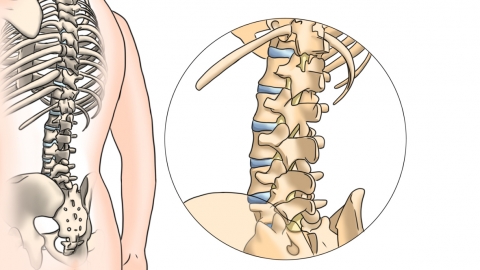What does it mean when one vertebra in the spine is slightly more prominent?
Under normal circumstances, the main causes of a slightly elevated bony prominence on a spinal vertebra include long-term poor posture, congenital vertebral developmental abnormalities, spinous process inflammation, lumbar disc herniation, spondylolisthesis, and others. If discomfort occurs, it is recommended to seek timely medical evaluation and treatment at a正规 hospital. Detailed analysis is as follows:
1. Long-term Poor Posture
Prolonged bending, slouching, or sitting can lead to imbalanced forces on the spine, causing excessive protrusion of a single vertebral spinous process and resulting in a visible lump. Corrective measures include adjusting sitting and standing posture, maintaining an upright spine, using lumbar support cushions, getting up periodically to move, and performing spinal stretching exercises.
2. Congenital Vertebral Developmental Abnormalities
Congenital malformations of the vertebrae may become more noticeable with age or physical development, often without significant pain. Avoid excessive spinal loading, choose a supportive mattress that maintains the spine's natural curvature, and undergo regular spinal examinations to monitor changes.

3. Spinal Spinous Process Inflammation
Chronic strain or exposure to cold may cause aseptic inflammation in the spinous process and surrounding soft tissues. Inflammatory stimulation leads to swelling and prominence of the spinous process, often accompanied by local tenderness. Under medical guidance, medications such as celecoxib capsules, diclofenac sodium enteric-coated tablets, or ibuprofen sustained-release capsules may be used. Anti-inflammatory and analgesic plasters can be applied locally, and prolonged sitting or bending should be avoided.
4. Lumbar Disc Herniation
Herniated intervertebral discs compress surrounding tissues, leading to compensatory vertebral prominence, often accompanied by low back pain and leg numbness. Under medical supervision, medications such as mecobalamin tablets, eperisone hydrochloride tablets, or meloxicam tablets may be prescribed. Lumbar traction therapy may also be beneficial. In severe cases, surgical removal of the herniated disc nucleus (discectomy) may be required.
5. Spondylolisthesis
Damaged connecting structures between vertebrae cause one vertebra to slip forward or backward, creating a localized bulge, often associated with dull back pain and restricted movement. Under medical guidance, medications such as etoricoxib tablets, compound chlorzoxazone tablets, or Huoxue Zhitong capsules may be used. Wearing a spinal brace can provide support. In severe cases, surgical reduction and internal fixation may be necessary.
In daily life, maintain proper posture and avoid prolonged bending or sitting; strengthen back and core muscle exercises; keep the spine warm and avoid chilling; choose a medium-firm mattress to support the spine’s natural curvature; and undergo regular spinal check-ups to detect abnormalities early.





